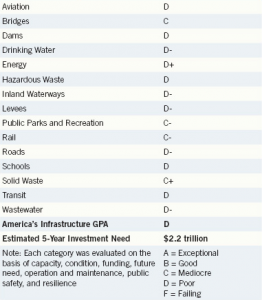
With the recent passing of a new federal Highway bill, America’s crumbling roads and critical structures seem, politically, to have been saved. However, the bill was actually gutted in a way that seriously disappointed those engineers and industry professionals who advised politicians on our need for revitalized infrastructure. The original bill, passed in the Senate, was a largely bipartisan effort that sought to seriously revamp the funding for the repair of our roads and bridges, and even appropriated more funds to public transportation, a move that only makes sense in a time of high gas prices and unemployment.
These measures did not sit well with the House of Representatives, with a great majority of the measures being stripped out and overwhelming cuts being made to the federal highway budget. The initial proposal by the house called for the ending of all public transportation funding, but fortunately for those who rely on public transport for work, Congress was able to compromise and only some cuts will be going through.
According to the American Society of Civil Engineers (ASCE), the United States has an overall D rating on the condition of its infrastructure. The report card grades each facet of American infrastructure according to the overall safety, funding, condition, future need and more in order to reach its conclusions. With help from local government statistics and independent research, the ASCE is able to publish a comprehensive report on our transit, utilities and other critical structures. Most Americans do not realize that it is these structures that allow them to live a comfortable modern life. If we do not take care of them properly, it is possible they will crumble with time. What does that say about us as a society? How can that possibly lead to a better future?
Fortunately, some state legislators are looking to pick up the slack where the federal government has failed the people. In Arkansas, Connecticut, Georgia, Louisiana, Maine and Washington, legislators met with policy experts and advocates from ASCE and other advocacy groups in order to hone in on local transportation issues and what they can do to solve the latest problems. Referring to the “Failure to Act” report published by the ASCE, one Connecticut legislator remarked that “We need to convince our constituents that there is a need for our state government to increase its investment in infrastructure. These reports can help us do that.” For now, it appears as though the duty of preserving our crumbling infrastructure will fall on state’s shoulders, until the federal government decides to pass a comprehensive highway bill that actually addresses 21st century problems in a 21st century manner.


